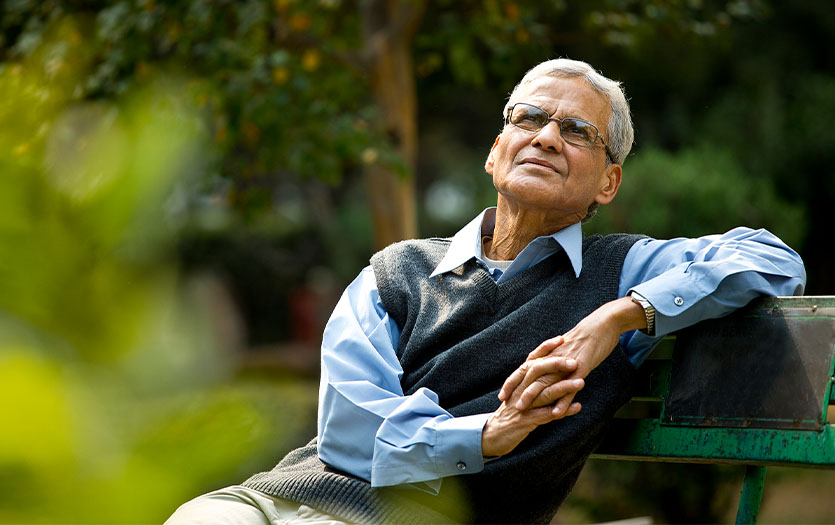Enjoy this monthly mindfulness post from Dave Johnson, PhD, CNS- BC, LMFT, employee assistance specialist.
I have always known how to sway, to move slowly backward and forward or from side to side. Perhaps it was my attention deficit or inner feelings of anxiety, but I recall grade school teachers asking me to sit still. See, I was more comfortable standing in the back of the class (or church or boardroom) and moving rhythmically back and forth. I found this slow, gentle, tender movement calming.
I carried it into adulthood and, not to brag, I became a bit masterful at calming babies and small children. Having had six kids and now ten grandchildren, I’ve had good practice holding and soothing and perfecting the slow sway. The gentle right to left, back and forth never fails to deliver a rock solid, calm equilibrium that synchs my spirit and grounds me, and of course, the young ones I hold.
As I learned the science of mindfulness and worked as an advanced practice nurse in mental health, I developed an interest in helping others to self-soothe through the turbulent times of life’s journey. Anxiety and depressive disorders are the common colds of our time and undermine joy and happiness. The stuff of life rolls downhill and uncertainty and stress abound.
I recognized – and recognize – how traumatizing and unfair life can feel. For 40 years or so as a nurse and therapist, I witnessed pain and despair when folks experienced a loss of jobs, health, or relationships through death, divorce or separation. The brutal pain of war, violence, or suicide is more than hard to let go of and I am thankful for therapy, friendships, support groups and medications that help people to survive and adapt. My search for helping others calm the spirit following the storm led me to add mindfulness to the tool kit years ago, for myself first and then for others.
When I teach community and corporate groups to come out of their thinking and overthinking heads, we often practice mindfulness sensory awareness exercises. I explain that it is important to notice when we get lost in the narrative of self-talk, worry, anger, or shame in our heads and the way out of this rumination is coming to our senses. Literally. It seems simple … and it is to understand, but the practice is the key. Cultivation and sustaining equilibrium (a sense of balance) and equanimity (stability of mind) are side effects that come from mindfulness practice. The five senses of sight, hearing, touch, taste, and smell are easily accessed in this practice, but another sense sometimes forgotten is proprioception.
Sometimes proprioception is called “the sixth sense”. It is essentially an awareness of our body’s movements through time and space and our ability to intentionally change our movements based on our other sensory organs' input. With stress, we fight, flee or freeze. Emotions sometimes flood us and an intentional shift in motion sometimes is key to re-finding balance.
.jpg)
So, as we contemplate whether mindful meditation on the move is really possible, I offer the following observations …
- Notice SWAY in nature. A gentle breeze bends and moves the elements of our world. Whether we are focused on tree branches or gently flowing grains of wheat, rhythm and balance dance and sway in our fields and streams. Breathe in slowly through your nose and enjoy for a few moments the quality of experience appreciated as the world sways around you.
- Appreciate an experienced mom (or grandparent) SWAYING with a new baby. Notice the whispers of soothing and tenderness found in the flow from right to left or backward and forward. Recognize the energy flow of movement that is an art form in itself to behold. Grow your awareness of how this tender spirit is being passed forward from one generation to the next. What seems intuitive is learned muscle memory. Consider how this same soothing can be integrated into your own sensory awareness.
- Recall that every cell within us is in motion. Eardrums vibrate, lungs expand, and hearts beat. To be alive is to move. Still, water becomes a stagnant pond. Thank goodness when we have the energy or spark to fight, flee, or freeze; when we experience the metaphoric or real bear that chases us in life. Emotion can be raw and ruthless with physical or emotional pain. Notice the emotion and bring more awareness to the flow of everyday motion. Come out of the thinking and overthinking mind and focus on noticing and intentionally changing some of our movements to be a bit more intentionally slow, gentle, tender and calm.
- Consider a class in tai chi. This wonderful Chinese meditative martial art is often referred to as “meditation in motion”. The energy of moving in synchrony with others or even practicing a slow-moving pattern is profoundly grounding. Good research has given us reason to believe this is beneficial to our physical and emotional sense of balance. Formal practice helps one sustain focused attention and agility and flexibility needed for the life journey. Ahhh
- See the dance of life as SWAY. The rhythm and balance and synchronicity is universal and flowing in the life journey. When the dance gets interrupted, goes at a rhythm hard to sustain, or a pattern that seems dispiriting, consider becoming a bit of a fly on the wall. Become curious and actually set a motion within your being that is intentionally a more even keel. OK, I know how busy our lives are, but seriously turn on some slow dance music and in the privacy of your own home, take charge of a rhythm that is more compassionate, slow and gentle. I am not speaking metaphorically here. I literally mean changing or shifting emotion by noticing intentional motion changes that are within your control.
- Practice SWAY. OK, this might feel a bit silly if you are new to this way of thinking, but consider adopting a regular practice of sway. Standing with hands at your side, legs comfortably separated, knees gently flexed, move to the left foot and feel the weight of the body cross your midline and shift dominantly to the left foot. Cue into this awareness of slow movement and the actual body weight shifting to one side and then very slowly moving back to the midline where you notice complete weight balance and continue slowly to the right. Consciously inhale slowly through the nose and intentionally shift the exhale even a bit more slowly to the rhythm of this movement. Stay genuinely curious about the rhythm.
- Seek ways to practice SWAY. This will be easy once you are comfortable with the gentle movement. At the back of a church or temple, while waiting in shopping checkout lanes, at a standup desk (by now you must know I am a strong supporter of not sitting mindlessly), and in waiting rooms for most appointments are excellent places to informally practice. Classes in dance, tai chi, yoga, mindfulness and self-compassion can be wonderful times to formally practice. Intentionally stopping any time you are on a walk, on a porch, or patio is a great opportunity to get a few sways in. Add to your sensory awareness a gentle breeze, a cup of good coffee or tea, a hint of spring air, or a bundled-up baby in your arms and sway to the moment of peace. Experience the flow of transcending in awareness and a quickening of the spirit.
Helpful Resources
For a free one-on-one in-person or phone consultation with Dr. Dave or to find out more about Mindfulness & Stress Management programs, contact the Parkview Center for Healthy Living at (260) 266-6500. Mindfulness-based stress reduction (MBSR) practice has been extensively researched and proven helpful for coping with stress and change, grief, healthy eating patterns, pain, anxiety, depression and many other chronic disease and autoimmune disorders.



